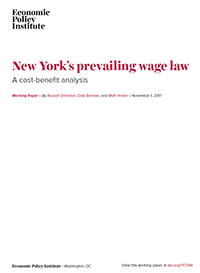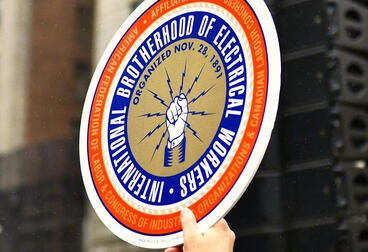The following is from the Economic Policy Institute. If you would like to read the entire working paper please click on the image below:
The link takes you directly to the Economic Policy Institute's website:
Executive summary
Beyond its role as a regulator, the New York state government has a critical function in the state’s construction industry: one of its largest customers. With a 2018 fiscal year capital budget of $14.5 billion, the policies and practices of the state government�as a consumer�significantly influence local construction labor markets. This presumably puts state lawmakers in the difficult position of having to balance two ethical considerations that, on the surface, appear to be mutually exclusive: the need to minimize taxpayer costs against the responsibility of ensuring fair wages, benefits, and safe working conditions for its residents on public construction projects.
To ensure that New York state fulfills the latter consideration, contractors working on state-funded government construction projects must adhere to the tenets of New York’s prevailing wage law. Enacted in 1897, this state policy requires that contractors pay their workers no less than the “prevailing” wage and benefit levels within the local construction market. In addition to its ethical underpinnings, the law also has an economic justification: it protects New York construction workers from being undercut by low-wage, often out-of-state contractors that may covet a large government construction contract and whose presence would take away jobs and erode working conditions for local residents.
State prevailing wage laws across the country have increasingly been assailed by those who appeal to lawmakers’ other responsibility�minimizing taxpayer costs�in an attempt to weaken or repeal these policies. These nationwide campaigns are built almost entirely upon a single argument: higher wages must equate to higher taxpayer costs. This narrative is simple, and its simplicity has made it a powerful political position that has been successfully exploited to overturn state laws in Indiana (2015) and West Virginia (2016). And with a recent publication by the Empire Center (McMahon and Gardner 2017), it has become apparent that some in New York will attempt to pitch the same narrative to state lawmakers.
There’s one problem. According to the most advanced economic research on state prevailing wage laws, the simple narrative largely isn’t true.
To separate fact from fiction as it relates to New York’s prevailing wage law, this report provides a thorough cost-benefit analysis of state policy relying extensively on independent, peer-reviewed research. As summarized in this report, academic economists from around the country have made prevailing wage laws a research priority over the last 15 years. In study after study, economists have found no evidence that these laws have had any significant cost effects on the biggest drivers of New York’s capital budget: highways and institutional buildings (e.g., schools).
How could the simple narrative be so wrong?
It turns out that the narrative relies on a subtle, yet egregious, logical fallacy that assumes that the only way that a contractor can minimize labor costs is by reducing the cost per hour of each worker. This is false. In any industry, an employer can also minimize labor costs by reducing turnover and/or the number of labor hours required. In construction, this would mean using higher wages to attract and hire the industry’s most productive workers and providing them with the most advanced equipment and technology. This high-wage, high-skill approach to minimizing cost is referred to as paying “efficiency wages,” a well-established strategy that is discussed in any introductory labor economics course. In the retail industry, this approach is what allows high-wage Costco and Wegmans to compete with low-wage Wal-Mart. Both paths can minimize costs, and it has been demonstrated convincingly in the academic research that high-wage contractors are able to exploit these cost offsets to place bids on public construction projects that are competitive with�if not better than�those of low-wage contractors.
In short, opponents of prevailing wage laws have shaped the political narrative surrounding these laws by, in part, successfully creating and defeating an implicit straw man argument that prevailing wage laws increase the�hourly cost per worker. That may be true. But the fundamental policy question is whether state prevailing wage laws increase�total construction costs.�From this perspective, the academic literature is clear and unequivocal: state prevailing wage laws have no effect on the biggest drivers of a state’s construction budget. Suggestions to the contrary, as found in reports authored by the laws’ opponents, consistently (and conveniently) ignore the academic research and instead rely on an empirical methodology that has been widely discredited among economists.
Opponents of state prevailing wage laws across the country have also shaped the narrative on these laws by focusing almost entirely on the presumed costs of the policy; recent analyses of New York’s policy by the Center for Urban Real Estate (Vitullo-Martin 2012) and the Empire Center (McMahon and Gardner 2017) follow a similar approach. This single-minded focus on construction costs has altered political discussion about prevailing wage laws in a powerful way: it has obscured all attention away from the benefits that these laws offer a state and its residents. That is unfortunate, as state prevailing wage laws have been demonstrated to improve the lives of workers, communities, contractors and construction consumers.
First and foremost, New York’s prevailing wage law strengthens and protects the state’s blue-collar middle class. By ensuring that New York state residents working on public construction projects receive fair pay and benefits, state lawmakers are directly responsible for creating and promoting the types of blue-collar middle-class jobs that have long represented the backbone of communities throughout New York state. This not only brings economic and personal security to New York families and communities, but it also adds hundreds of millions of dollars to the state’s economy and substantially increases New York’s state and local tax revenues.
New York’s prevailing wage law is also one of the few effective policy levers that promote a clear pathway to the middle class for non�college educated workers. As described in this report, New York state residents without a college degree have encountered dwindling economic opportunities in recent decades, and most jobs expected to become available to them in the near future offer poverty-level wages or below. A career in construction is an exception, as this is one of the few remaining industries where workers can earn a sufficient paycheck and receive health and pension benefits without a college degree. New York’s prevailing wage law promotes these middle-class career opportunities by incentivizing contractors to hire apprentices enrolled in state-sanctioned programs, many of which only require a high school diploma for admission. In doing so, state lawmakers are directly providing opportunities for inexperienced workers to acquire the on-the-job training necessary to develop into skilled tradespeople and the next generation of New York’s blue-collar middle-class.
The benefits of lawmakers’ support for apprenticeship programs through New York’s prevailing wage law also extend to the state’s contractors and construction consumers. Contractors have bemoaned skill shortages in construction for decades. While bona fide regional skill shortages can typically be resolved by increasing wages, contractors’ oft-used solution to a perceived skill shortage�recruiting and employing available out-of-region workers�represents a missed opportunity for policymakers interested in generating new jobs for local residents. Prevailing wage laws are one of the few effective policy levers available to promote on-the-job training and apprenticeships, thereby developing a skilled, in-state labor force capable of powering New York’s economic growth.
New York’s prevailing wage law is also consistent with the obligation of state and local governments to prioritize the bids of honest, fair-dealing contractors whose workplace practices adhere to labor and employment law. Under the policy, contractors working on state-funded projects must submit a project-wide certified payroll report that includes employees’ names, Social Security numbers, pay rates, and number of hours. The prospect of more stringent government oversight discourages bids from unscrupulous contractors whose competitiveness depends on illegal, but-cost saving labor strategies. By rooting out unethical actors, prevailing wage laws also advantage contractors with a greater commitment to workplace safety, as the academic research demonstrates that fatal and nonfatal injury rates in construction are substantially lower in states with these laws.
In sum, state lawmakers overseeing New York’s construction industry must weigh two ethical responsibilities that, on the surface, appear to be mutually exclusive: the need to minimize taxpayer costs and the responsibility of ensuring fair wages, benefits, and safe working conditions for its residents on public construction projects. A critical review of the current academic research in this report indicates that New York’s prevailing wage law may offer policymakers the opportunity to fulfill both responsibilities. On the biggest components of the state’s construction budget, the consensus of academic studies is that the policy has little to no effect on taxpayer costs. There is also considerable evidence that the policy raises the standard of living of a state’s residents, improves workplace safety, and offers a clear path to the middle class for New York state residents without a college degree. Taken together, research by independent, academic economists indicates that New York’s prevailing wage law is a uniquely valuable component of state policy that simultaneously uplifts residents and communities while imposing minimal, if any, cost on taxpayers.



